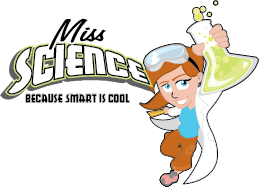Last month, I had the opportunity to work with a group of awesome fifth graders at Cherokee Elementary in Scottsdale, Arizona. The day before arriving at their school I’d given them a shout-out during my Arizona Midday (NBC-KPNX) segment about the Science of Toys and Games.
I showed viewers how to create a bioplastic using milk and vinegar. If your school doesn’t have a 3-D printer, this can be a great experiment to support project-based learning and game design. With the resources that I had curated using Collections by Destiny I was able to share videos, articles and weblinks that I had created for my Miss Science workshop with the viewers and the teachers I was working with. I even created a playlist for the teachers so that they could replicate my lessons.
My time at Cherokee was focused specifically around the science of plastics and how they have revolutionized the toy and game industry. Take the world’s oldest toys, for example: dolls and yo-yos. Each toy can be traced back to ancient civilization, and over several thousands of years they have been transformed, redesigned and created out of a multitude of materials.
Today it is almost impossible to find a toy or game that isn’t entirely created from plastic. Even the playing cards you use have a plastic or glue (which is made from polyvinyl acetate) on them. This led us to a terrific hands-on SLIME lab in which we used glue and borax to create our own slime solution. We compared it with a solution from Steve Spangler which, although the ingredients aren’t listed, I’m assuming is created from polyvinyl alcohol. Making your own PVA slime solution can be EXTREMELY time-consuming, so I recommend purchasing online.
We then talked about how plastics that help to build our toys and games are really just molded slime and how before the invention of the synthetic polymers that make up the plastics used today, people used caseins (a natural polymer) to replace materials such as ivory and wood.
Next, we took a look at how the yo-yo had been re-engineered and designed over time and learned about Pedro Flores, “the father of the yo-yo.” I had brought a Miss Science yo-yo for each student and they were more than thrilled to head outside and give them a try. I, along with the teachers, were astonished at how many students said they had never played with a yo-yo.
A yo-yo can teach so much about science and still be a whole lot of fun! We learned about potential and kinetic energy as well as simple machines while playing with our yo-yos. They loved it!! It was something different than the toys they use (most being video games when I surveyed them).
I was pleasantly surprised when I arrived for my second day of workshops to see one of the kiddos from the previous day’s class walking across campus playing with his new yo-yo. Success!
If kids aren’t playing with yo-yos, or much of anything that isn’t connected to an X-Box or PlayStation, then what are they playing with?
I did a little research and found an article from Popular Mechanics that listed the 30 most popular toys. It’s interesting because many of the “toys” they highlighted (high-tech, low-tech and no-tech) are far more than toys. They are learning tools. Learning tools such as Sphero, Littlebits and Ozobots that we find in most K-12 Makerspaces. Nothing makes me happier than when I go into a school and not only see students using these learning tools, but teachers facilitating instruction beyond the learning tool. It’s great to learn how to program a Sphero, but what about using it to connect STEM with other subjects?
The students at Cherokee not only learned about polymers through slime and the physics of a yo-yo, but they found out how the Engineering Design Process (EDP) is an important part of innovation and game design (even yo-yos).
We learned the story of Milton Bradley and even mapped out how he would have used something like the EDP to create his games. We built connections between writing and the EDP and created our own ideas for prototypes that we could develop into our own games. Some required nothing more than cards, others required serious coding. Some would need 3-D printing for game pieces, customized dice or even a yo-yo.
It is through experiences like these that we not only get students engaged, we empower them. They learn that reading can expand their horizons and help them to connect the dots that they didn’t see before. They learn that inventors and innovators don’t get things right the first time.
Failure helps us to improve not only what we create, but ourselves as well. They become responsible for their own work. It is through their ownership that they can develop skills and acquire knowledge to last a lifetime.
Posted on Follett Community: https://www.follettcommunity.com/s/article/it-all-started-with-a-book-and-a-yo-yo
